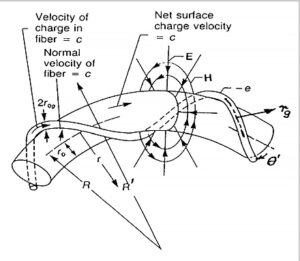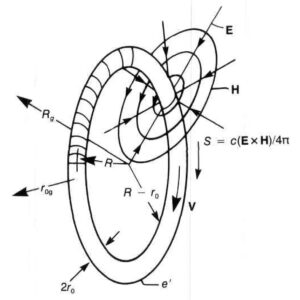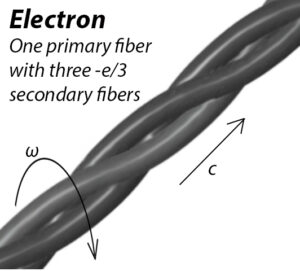Raul Fattore
May 26, 2023
Table of Contents
Abstract
The need for some physics thoughts on the concept and definition of charge, particle, and atom is becoming important in modern physics. In textbooks as well as in many scientific publications, authors, deliberately or not, violate those basic concepts and their profound physical meaning, whose ignorance yields erroneous results.
Keywords
Enel: “Energy Element”
Basel: “Basic Element”
Introduction
The intention of this paper is to update some basic concepts of physics and redefine others, considering the New Atomic Model and the Classical Electromagnetic Theory of Elementary Particles.
- What is an electric charge?
- What is a particle?
- Is charge a particle?
- What is the real atom?
- What is matter?
- How is energy converted into matter?
The answers to the above questions are understandably given in the development of this work, which is based on the experimental results carried out over many years by prominent scientists:
- Spinning Ring Model of Elementary Particles (toroidal ring of continuous charge)
- New Atomic Model
- Classical Electromagnetic Theory of Elementary Particles
What is Charge?
Until now, there has been no adequate definition of what charge is. Why? Because it is not well understood what it really is.
Before defining charge, let’s first clarify the error that has been made to date in books and scientific publications on the definition of the atom. In second place, let’s review the relationship between mass and energy and its meaning.
Redefining the Atom
The experiments carried out by physicists in the past and present with the wrongly called “particles”, and the endless process of the discovery of “new particles” (over 100) [5], clearly show us that we must rethink the atom as Democritus defined it almost 2400 years ago: the smallest physically indivisible and indestructible piece of matter.
The “physically indivisible” atom notion is violated by the atom model that is provided in textbooks and even in papers by well-known scientists. It is incorrect to refer to the model of an atom made up of protons, neutrons, and electrons as an atom. Simply put, an element with given qualities is formed by a particular collection of charges. It is divisible and modifiable. It may also be referred to as “basel” or “Basic Element.”

Bostick’s toroidal charge fiber ring
The New Atomic Model, which is based on experimental results [1, 2], gave rise to the Classical Electromagnetic Theory of Elementary “Particles” [3] based on the Charge-Fiber Ring Model of Elementary “Particles” (Fig. 1). This theory seems superior to the Standard Model of Elementary “Particles” [5].
The charge “fiber” or “string” is an end-to-end closed loop helix that forms an imaginary ring or torus.
This elementary charge helix has a combined rotational and translational motion along its central axis, with right- or left-handed helicity, and can have a charge of +e/3 or -e/3, where e is the electron charge.
The elementary closed loop charge helix (Fig. 2) can absorb electromagnetic energy and keep it “trapped” in the form of a standing wave. It can support multiple resonant states. This wave confinement leads to quantization, i.e., the existence of discrete states with discrete energies. Eventually, this energy can be radiated.

Bostick’s toroidal ring
Bostick’s experiments with plasma from 1956 to 1985 suggest two types of “rope-like” organizations of the elementary charge helixes [3]:
- An elementary charge helix can be intertwined with two or more charge helixes.
- Elementary charge helixes can be packed inside other helixes. A big primary helix may consist of smaller intertwining secondary helixes bound with higher binding energy, which in turn may consist of very small intertwining tertiary helixes bound with very high binding energy.

Three elementary charge helixes make up the electron.
In Fig. 3 we see a short length of the electron toroidal ring. The electron is made up of one primary fiber with three elementary intertwined charge helixes that are very tightly bound and balanced by electromagnetic forces at a very close distance.
Under normal circumstances, they don’t touch each other. Very strong external forces may break this structure by completely unbinding the elementary charge helixes.
The levels of subdivision of the elementary charge helix are unknown, but taking three levels (primary, secondary, and tertiary) is sufficient to explain all the known “particles” up to date.
Bostick observed from his experiments [2] that the elementary charge helix is caused by an electromagnetic vortex. This vortex is analogous to those found in fluids and has soliton properties.
This remarkable finding reveals two important properties of the elementary closed-loop charge helix:
- The elementary charge helix is of electromagnetic origin.
- The elementary charge helix can be transmitted by any means over very long distances, reflected, refracted, and diffracted almost without losing energy or undergoing any alterations of any kind.
Bostick used Classical Electrodynamics to make the model of the elementary charge helix. The second property explains the so-called “particle-wave duality” behavior without any need for Quantum Theory.
The elementary charge helix is the real atom.
Now that we have a better understanding of charge and some of its properties, let’s think about the relationship between mass and energy.
The Mass-Energy Relationship
The link between mass and energy is present in some physics equations, which are mainly derived from mechanical motion and interactions. However, this is not the case in electrodynamics. Why?
Through time, the same forces in Mother Nature have been expressed in terms of two different quantities, such as mass and charge. However, the Universal Electrodynamic Force reveals that mass has an electromagnetic character. It is caused by the vibration of charges. This changes the concept of mass, which is usually referred to as only a certain amount of matter.
The elementary charge helix described as an electromagnetic vortex in previous paragraphs, has a finite size, has a complex associated electromagnetic field with tensile properties, and has mass. This is the most elementary relationship between electromagnetic energy and mass.
Elementary charge helixes form groups to make electrons, protons, and neutrons, which in turn group to make a basel, which in turn groups to make lattices or molecules by making bulk matter.
Then, we can conclude that electromagnetic energy is matter and vice versa.
Mass and energy are two quantities with the same origin that manifest in different forms. The conversion from one form into the other is reversible. Mankind successfully managed to convert matter into energy (for evil purposes first), but is still struggling to do the opposite. However, Mother Nature continuously converts energy into matter in the universe.
How does Mother Nature Convert Electromagnetic Energy into Matter?
Perhaps the most common way is by neutron decay. As explained in the article on Negative Mass in Atom Nuclei, the neutron is a bound between a proton and an electron. The result of the neutron decay (half-life less than 15 minutes) is the separation of the very tightly bound proton-electron, plus a “particle” called electron antineutrino, which has zero net charge, and a very tiny additional amount of energy (mass). Most probably, this might be a field of radiating energy produced by the decay.
The pair proton and electron will now have a weaker bound and form the most elementary basel which is the first element in the periodic table: Hydrogen.
Thus, Mother Nature converts energy into matter.
Definition of Charge
Charge is the elementary electromagnetic energy element (enel), whose complex field extends to infinity.
The enel has a finite size, its electromagnetic field has tensile and soliton properties, and it is the cause of all types of forces.
The enel is made of the elementary closed-loop charge helix, which is the real atom. The complex field, on the one hand, has the propagation properties of a classical electromagnetic field in dispersive and non-dispersive media, and on the other hand, is a soliton whose amplitude decays hyperbolically with distance in a very smooth way [6], approximately proportional to ![]() , while its duration increases proportional to
, while its duration increases proportional to ![]() .
.
These combined field properties maintain the same energy level for very long distances, so the interactions in short, medium, and long ranges are guaranteed.
Features of Charge
The universe is connected by continuous radiation. As explained in this article, every enel in the universe is under the influence of all the others. There is an endless dynamic interchange of energy. Nothing is isolated, and nothing is at rest. Since zero-degree Kelvin is not known to be reached in the universe, it is safe to assume that the enels in the basel always vibrate, and radiate continuously, sending an electromagnetic field to other enels. Therefore,
- Charge is the real atom.
- Charge and its field are one entity. Making field changes will affect the charge, and vice versa.
- The complex field has tensile and soliton properties.
- Charge is responsible for electric, magnetic, and gravitational interactions.
- A “stationary” charge does not exist.
- A single “isolated” charge is highly unstable. It will rapidly seek to combine with other charges.
- Stable configurations are attained for combinations with net charge 0 or ±e.
- A configuration with a specific number of charges forms the basel.
How is the Charge Sign Defined?
Classically, the sign of charge is arbitrarily defined as being “positive” or “negative”, because it is determined by an electric potential difference, which is also arbitrarily defined. “Positive” and “negative” are relative assignments with respect to some references.
In the enel, the sign is also arbitrarily defined according to the rule of left-hand or right-hand helicity.
How are Charges Attracted or Repelled?
The attractive or repulsion force between two elementary charge helixes is determined by the laws of Electrodynamics. Two enels with equal helicity will attract each other and repel each other if they have opposite helicity.
Enels may form up to three levels of different intertwined combinations that are balanced by electromagnetic forces. These combinations explain all known “particles” in the Classical Electromagnetic Theory of Elementary “Particles” [3]. This theory could even explain “particles” still to be discovered.
Unfortunately, most published books and scientific papers still refer to the primitive concept from Coulomb’s time of “charge sign” to define the interaction. Remarkably, this is the easiest way to calculate the type of force on a charge or between charges. It is enough to assign the proper sign or signs.
What is a Particle?
The definition of particle in the dictionary can be shortened to “a very small portion or amount of matter”. In physics, this definition was extended to include “one of the extremely small constituents of matter, as an atom or nucleus”, and it is also attributed to all elementary particles discovered up to date.
However, at the time of developing some theory or making calculations, there is no consensus in physics about what a particle is. According to the mathematical convenience used by the authors, a particle can be:
- A point-like object.
- A point-like object with physical properties.
A point-like object has no dimensions. It does not exist. If it does not exist, how can it have physical properties? That is perfect nonsense!
The concept of a particle is relative. The words “small” or “big” mean nothing if we don’t specify dimensions. A car could be a particle compared with planet Earth, and the Milky Way could be a particle compared with the universe.
For this relativeness to disappear, we must establish some dimension limits for a particle as an element of matter.
Redefining Particle
Considering the concepts from the previous paragraphs, charge and particle have similar definitions. However, it could be good practice to establish some dimensional limits.
A particle is an elementary electromagnetic energy element (enel), or enel composite with a maximum diameter of 1 fm (![]() ).
).
The mass is already implicit in the enel. As this elementary charge helix (enel) can be intertwined with two or more charge helixes, they will form particles of different sizes and masses, such as the electron, which is made of three intertwined helixes.
A particle is not a “point-like object”, and it is not a “massless photon.” A particle is of electromagnetic origin, it has a finite size, charge, and mass [2].
Is Charge a “Particle”?
The term “particle” in physics is usually associated with a point-like object. As stated in the previous paragraph, a point has no dimensions; therefore, it doesn’t exist, and no physical properties can be granted to it.
According to the definition of particle previously given and the definition of charge derived from the New Atomic Model, charge can be considered a particle.
Is Any Single “Particle” a Charge?
The New Atomic Model described in the article about Negative Mass in Atom Nuclei shows that all “particles” making up the wrongly called “atom” are composite charges. Therefore, any single one of those particles has a charge value, with a self-electromagnetic field as its extension. There are no “neutral particles”. The so-called “neutral particles” are composed of charges that balance the net result.
What is Matter?
Considering the periodic table of elements related to the concepts and definitions derived in this article, matter is a specific association of atoms that follow the laws of electrodynamics. Recall that an atom is the elementary closed-loop charge helix.
Conclusions
Considering the New Atomic Model and the Classical Electromagnetic Theory of Elementary Particles, new and updated concepts, and definitions have been given for Atomic Physics and Particle Physics.
The definitions of Charge and Particle, which have always been obscure in physics, have been given in very clear and simple statements.
The concept of the atom, which has been misused in physics for a long time, has also been updated and adequately clarified.
The already-known relationship between Energy and Matter has been further enhanced with new concepts, and the conversion of Energy into Matter has been demystified.
Bibliography
[1]. Arthur H. Compton, “The size and shape of the electron” (1918), Journal of the Washington Academy of Sciences, Vol. 8, No. 1, https://www.jstor.org/stable/24521544
[2]. Winston H. Bostick, “The Morphology of the Electron”, International Journal of Fusion Energy, Vol. 3 No. 1, pp. 10-53 (1985), http://wlym.com/archive/fusion/ijfe/19850101-IJFE.pdf
[3]. Charles W. Lucas, Jr., “A Classical Electromagnetic Theory of Elementary Particles” (2004-2005), Part 1, Part 2
[4]. W. J. Hooper, “New Horizons in Electric, Magnetic, and Gravitational Field Theory”, (Electrodynamic Gravity, Inc., 1974), https://electrogravityphysics.com/wp-content/uploads/1-Hooper-New-horizons-in-EM-and-gravitational-field-theory-transcription.pdf
[5]. Fermi National Accelerator Laboratory, https://www.fnal.gov/pub/science/inquiring/matter/madeof/
[6]. Wencheng Hua, Jingli Rena, Yury Stepanyants, “Solitary waves and their interactions in the cylindrical Korteweg–de Vries equation” (2023), https://arxiv.org/pdf/2301.06144.pdf
